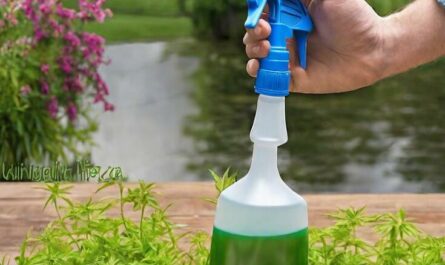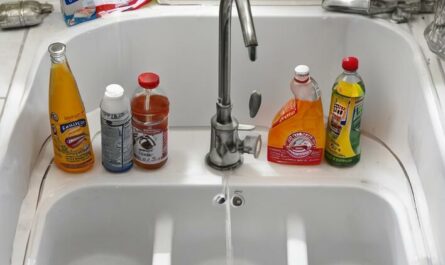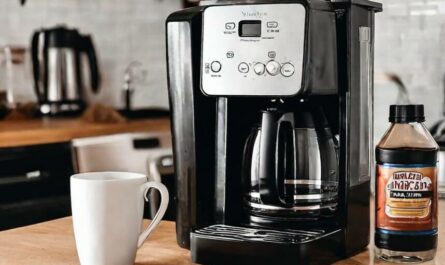Clogged drains are a common household issue. It can cause frustration, inconvenience, and even potential water damage if left unaddressed. While chemical drain cleaners are readily available, they often contain harsh chemicals that can be harmful to the environment and even your health. Fortunately, there’s a natural, safe, and effective solution right in your pantry: baking soda and vinegar. This article will discuss how to unclog a drain with baking soda and vinegar step by step.
It’s important to note that while baking soda and vinegar can be effective for minor clogs, severe or persistent blockages may require professional drain cleaning tools. This method works best for clearing out hair, soap scum, light grease, or food particle build-up in routine drain maintenance. For tough clogs that cannot be cleared, you need to call a professional plumber.
Science Behind Baking Soda and Vinegar
Baking soda, also known as sodium bicarbonate, is a mild alkali that can help dissolve grease, hair, and organic matter. Vinegar, on the other hand, is an acid (acetic acid) that can help break down mineral deposits, soap scum, and other buildup.
When these two substances are combined, they create a chemical reaction that produces carbon dioxide gas. This fizzing action can help dislodge and push through clogs.
The chemical reaction between baking soda and vinegar is a simple acid-base reaction. When the baking soda (a base) and vinegar (an acid) are mixed, they neutralize each other, forming carbonic acid.
This unstable compound quickly decomposes into carbon dioxide gas and water. The rapid release of carbon dioxide gas creates the familiar fizzing and bubbling action. This can help dislodge and break up clogs.
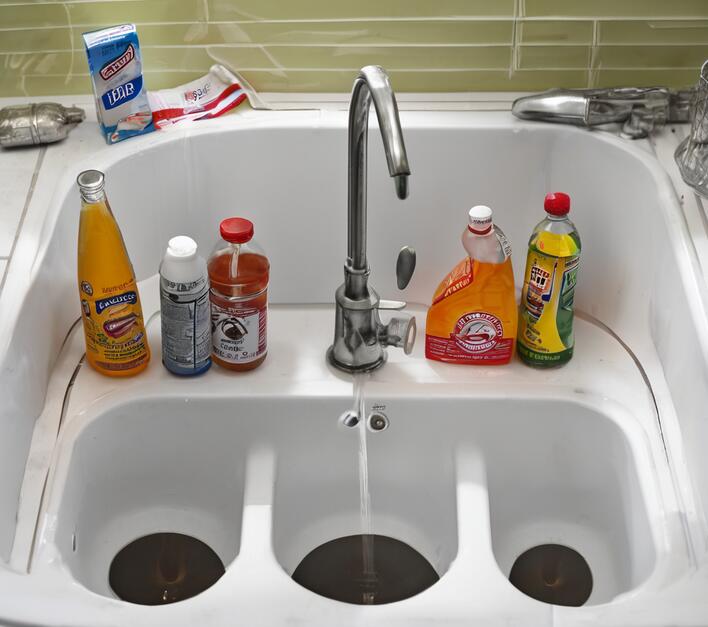
Preparing to Unclog Your Drain
Before you begin the process of unclogging your drain with baking soda and vinegar, it’s essential to gather the necessary materials and take some safety precautions.
Materials Needed:
- Baking soda
- White vinegar or apple cider vinegar
- Boiling water
- A clean cloth or drain plug
- Gloves (optional)
- Protective eyewear (optional)
- Plunger (optional)
- Drain snake or auger (for severe clogs)
- Bucket or container (for catching water overflow)
Safety Tips:
- Work in a well-ventilated area to avoid inhaling any potential fumes from the reaction.
- Wear gloves and protective eyewear to protect your hands and eyes from any splashes or spills.
- Keep children and pets away from the work area.
- Use caution when handling boiling water to avoid burns.
- Have a bucket or container nearby to catch any water overflow during the process.
How to Unclog a Drain With Baking Soda and Vinegar?
1. Clear the Drain Area
Remove any visible debris, hair, or objects from the drain cover or strainer. Use a drain hook, tweezers, or needle-nose pliers to pull out any hair or gunk you can reach. This will allow the baking soda and vinegar solution to work more effectively on the clog itself deeper in the pipes.
2. Pour Baking Soda into the Drain
Pour between 1/2 cup to 1 cup of baking soda directly down into the drain opening. For smaller drains like bathroom sinks, use around 1/2 cup. For larger drains like kitchen sinks, bathtubs, or showers, you can use closer to 1 full cup of baking soda. The baking soda will help break down grease, hair, and organic matter in the clog.
3. Add Vinegar
Slowly pour 1 cup of vinegar into the drain after the baking soda. The vinegar will react with the baking soda, creating a fizzing action. You can use either white distilled vinegar or apple cider vinegar. The acid in the vinegar helps dissolve mineral deposits.
4. Cover and Let It Sit
Immediately after pouring in the vinegar, cover or plug the drain opening tightly with a drain cover, small plate, or clean cloth. This will help contain the chemical reaction inside the drain pipe and build up pressure to push against the clog.
Allow the baking soda and vinegar mixture to sit for 15-30 minutes. The longer it sits, the more time it has to work on breaking down the clog.
5. Flush with Boiling Water
After 15-30 minutes, remove the drain cover carefully, as the built-up pressure may cause the mixture to spray up. Then slowly pour a kettle or pot of boiling water down the drain opening.
The boiling water will help further dissolve the clog that was loosened by the baking soda and vinegar reaction. Pour slowly to avoid splashing and splattering.
6. Use a Plunger (Optional)
If the drain is still clogged or draining slowly after flushing with boiling water, you can try using a plunger to help dislodge the clog. The plunging action combined with the baking soda/vinegar can provide extra force to break through the clog. Plunge firmly about 10-15 times to agitate the mixture.
7. Repeat if Needed
If the clog persists after one attempt, you can repeat the full process of baking soda, vinegar, and boiling water again. Sometimes it takes a few rounds to fully clear a stubborn drain clog. Let it sit for 30-60 minutes before flushing with boiling water again.
8. Add Salt (For Tough Clogs)
For extremely tough drain clogs, you can try adding 1/2 cup of salt along with the baking soda before the vinegar. The salt can provide some mild abrasive action to help scrub the clog away when combined with the fizzing reaction.
9. Use Baking Soda and Vinegar Regularly
To help prevent future clogs, consider pouring 1/2 cup baking soda and 1 cup vinegar down your drains monthly. Let it sit for 15 minutes before flushing with hot water. This helps break down any buildup.
10. Try Drain Cleaning Tools
If the baking soda and vinegar method still does not unclog the drain fully, you may need to use a drain snake, zip-it tool, or plumber’s auger to physically break up and remove the clog. These tools can dislodge hair, soap scum, and debris that is tightly stuck.
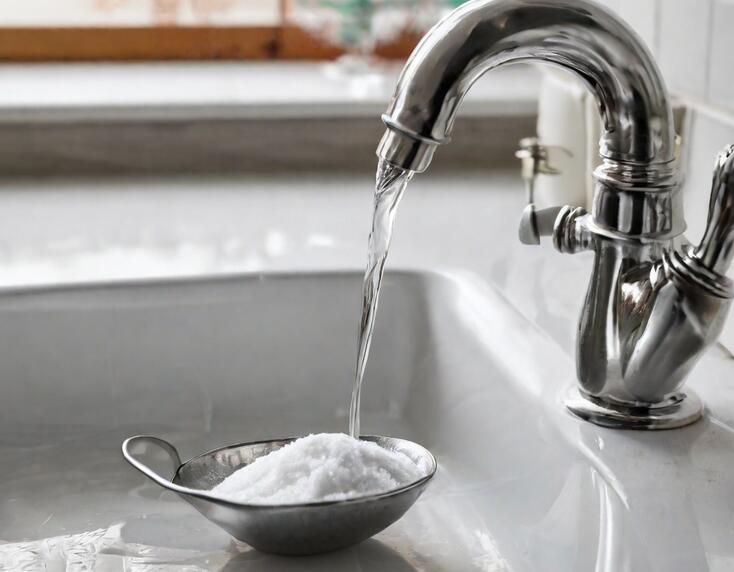
Tips and Tricks for Effective Drain Unclogging
While the baking soda and vinegar method is generally safe and effective, some tips and tricks can help ensure successful drain unclogging:
- Use Hot Water First: Before using the baking soda and vinegar solution, try pouring a pot of hot water down the drain. This can help loosen any debris or grease. This makes it easier for the baking soda and vinegar to work.
- Add Salt or Dish Soap: For stubborn clogs, you can add a few tablespoons of salt or dish soap to the baking soda and vinegar mixture. The salt can help scrub away buildup, while the dish soap can help break down grease and oils.
- Use a Funnel: If you’re dealing with a small drain opening, use a funnel to help pour the baking soda and vinegar into the drain without spilling.
- Repeat the Process: If the clog persists after the first attempt, don’t hesitate to repeat the baking soda and vinegar process. Sometimes, it takes multiple rounds to fully clear a stubborn clog.
- Use a Drain Snake or Auger: For more severe clogs, you may need to use a drain snake or auger to physically break up and remove the blockage. These tools can be purchased or rented from hardware stores.
- Prevent Future Clogs: To help prevent future clogs, consider pouring a mixture of baking soda and vinegar down your drains regularly (e.g., once a month). This can help keep your pipes clear and free of buildup.
When to Call a Professional?
While the baking soda and vinegar method can be effective for minor clogs, there are certain situations where it’s best to call in a professional plumber:
- Severe or Persistent Clogs: If the clog is severe or persists despite multiple attempts with baking soda and vinegar, it’s time to seek professional help. Plumbers have access to specialized tools and techniques that can tackle even the toughest blockages.
- Slow Drains Throughout the House: If you’re experiencing slow drains throughout your home, it could be a sign of a more significant issue with your main sewer line. A plumber can inspect and address the problem.
- Recurring Clogs: If you find yourself dealing with recurring clogs in the same drain, it may be an indication of a larger issue. A professional plumber can diagnose and repair the underlying problem.
- Lack of Improvement: If you’ve tried the baking soda and vinegar method multiple times without any noticeable improvement, it’s best to call a plumber. They can assess the situation and recommend the appropriate course of action.
- Potential Pipe Damage: If you suspect that your pipes may be damaged or corroded, it’s crucial to have a professional plumber inspect and repair them. Attempting to unclog damaged pipes with DIY methods could potentially cause further damage.
- Septic System Issues: If you have a septic system, it’s important to exercise caution when using any drain unclogging methods. Because they could potentially disrupt the delicate balance of bacteria in your septic tank. In such cases, it’s best to consult a professional plumber or septic service provider.
FAQs
1. How much baking soda and vinegar should I use?
For most drains, use around 1/2 cup of baking soda followed by 1 cup of vinegar. For larger drain pipes like bathtubs or kitchen sinks, you can increase it to 1 cup of baking soda and 1 cup of vinegar.
2. Can I use any type of vinegar or does it have to be white vinegar?
You can use either white distilled vinegar or apple cider vinegar. The acetic acid in both types of vinegar will react with the baking soda to create the fizzing action.
3. How long should I let the baking soda and vinegar sit in the drain?
Let the mixture sit for at least 15-30 minutes before flushing with hot water. The longer you can let it sit, the better, up to 1 hour for tough clogs.
4. Do I need to cover the drain after adding the baking soda and vinegar?
Yes, covering the drain opening helps contain the chemical reaction and build up pressure to push against the clog. Use a drain cover, plate, or cloth.
5. What temperature water should I use to flush the drain?
You can use boiling or very hot water to flush the drain after letting the baking soda and vinegar sit. The heat helps further dissolve the clog.
6. Is it safe to use baking soda and vinegar on all types of drain pipes?
This method is safe for most drain pipes made of PVC, metal, or porcelain. Avoid using it on older pipes that may be compromised or damaged.
7. How often should I use baking soda and vinegar to prevent clogs?
For maintenance, pour 1/2 cup baking soda and 1 cup vinegar down drains monthly and flush with hot water. This helps break down buildup.
8. What if the baking soda and vinegar don’t unclog the drain?
If the clog persists after a few attempts, you may need to use a plunger, or drain snake or call a professional plumber who has more powerful drain cleaning equipment.
9. Can baking soda and vinegar damage my pipes?
When used properly, baking soda and vinegar should not damage pipes. But avoid letting the mixture sit for excessive periods and don’t use on cracked or compromised pipes.
10. Is this method effective for grease clogs in kitchen sinks?
Baking soda and vinegar can help dissolve some grease and food particle buildup, but for major grease clogs, you may need an enzyme drain cleaner or professional service.

